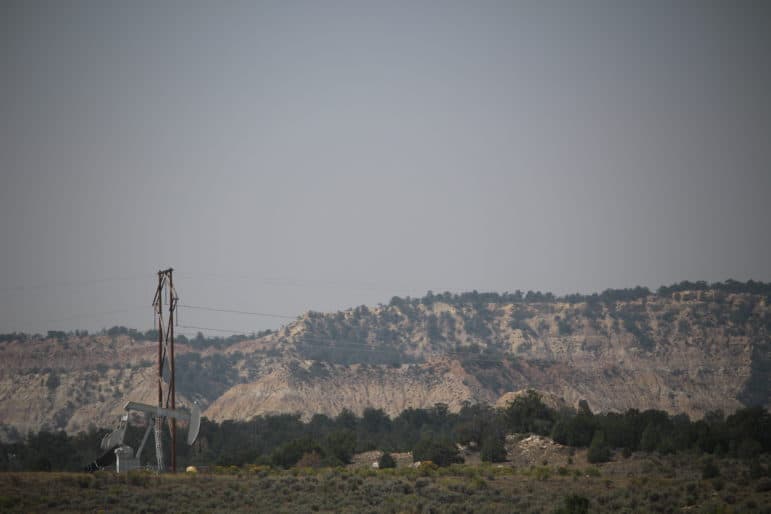
Laura Paskus / New Mexico Political Report
A gas well in Rio Arriba County.
At its meeting on Thursday, the New Mexico Oil Conservation Committee will hear from an energy company that wants to double the density of gas wells in northwestern New Mexico.
Hilcorp Energy Company is asking the state to amend well density requirements in what’s called the Blanco-Mesaverde Gas Pool in San Juan and Rio Arriba counties.
Under the current rules, companies can drill four wells within the designated 320-acre spacing units, and only two can be drilled within each 160-acre section. Companies can also ask the state to increase the density of wells on a case-by-case basis, something Hilcorp notes in its application New Mexico has allowed it to do in 62 instances this year.
Rather than continuing to file individual applications, each with its own public notice and hearing, the company is now asking New Mexico to change the spacing rules for the entire Blanco-Mesaverde pool.
In its application, attorneys for the company point out that the rules adopting the 320-acre units were established in 1949 “on the assumption that one well would adequately drain and develop 320-acres.” Over time, the Oil Conservation Division has increased the well density. And the company says it should do so again to “prevent waste and drain unrecovered gas reserves.”
The state makes the density rules on all leases, even if they are on federal lands. Then the relevant agency, such as the U.S. Bureau of Land Management, approves or denies applications for permits to drill.
According to the company’s application, it currently operates 5,239 wells within the Blanco-Mesaverde Gas Pool.
In 2017, ConocoPhillips sold its San Juan Basin assets to Hilcorp Energy Company. Earlier this summer, the Houston Chronicle reported that an affiliate of Hilcorp, Harvest Midstream, was buying gas pipeline and processing facilities in the San Juan from Williams Partners. That $1.1 billion sale included more than 3,700 miles of pipeline, two gas processing plants and one carbon dioxide treatment facility.
Group calls for state to delay decision
Mike Eisenfeld of the San Juan Citizens Alliance was one of the people who spotted Hilcorp’s legal notice in the back of The Farmington Daily Times on Aug. 23 and 24. He said that the change could mean up to 7,500 new wells in the two counties.
Eisenfeld’s group wants the state to delay its decision and have “more active and robust hearings” on the change. They’re planning to file a request for a continuance, or deferral, at Thursday’s meeting. That would allow interested parties to prepare an intervention or provide testimony on issues such as environmental impacts, he explained, and also give residents and landowners more time to plan to attend the hearing in Santa Fe.
Although the rule change would apply to only two counties, Eisenfeld thinks it could have larger implications.
“This would be a major rule-making and would open to the door to all sorts of formations [in addition to the Blanco-Mesaverde pool],” Eisenfeld said. “It would slaughter the places that have oil and gas.”
One local landowner, Don Schreiber, is worried the Oil Conservation Commission will approve the change.
“If it’s two wells per 640 acres, as it was originally, then we’re talking multiple use,” he said, referring to a mandate for public lands, which allows for various uses on one plot of land, whether that’s oil and gas drilling, livestock grazing, recreation or other uses. “If it is 16 wells per 640 acres as is proposed, then we’re talking an 11,000-square mile industrial zone.”
He also called the timing of the request a “last-ditch, lame-duck gift to industry by two ex-oil company executives as they leave.”
Two top officials with the New Mexico Energy, Minerals and Natural Resources Department came to state service from the oil and gas industry. Secretary Ken McQueen retired as San Juan vice president from WPX Energy shortly before his appointment by Gov. Susana Martinez in late 2016. WPX Energy is a subsidiary of Williams Companies. The current director of the Oil Conservation Division is Heather Riley, who was formerly WPX’s senior regulatory specialist in New Mexico.
“On their way out the door, McQueen and Riley are trying to make another big payoff to the oil industry; doubling the drilling in the majority of the San Juan Basin and forever removing New Mexico citizens, or their federal representatives, from participating in the critical process of determining just how many wells an oil company can drill,” said Schreiber, who owns a ranch in the area and has been a vocal opponent of increased drilling.
When asked if the commission will issue a decision at Thursday’s meeting or just collect information about the application, a spokesperson for the department pointed out that the agenda states the “hearing may continue to following days if not completed.” If the hearing is completed, the commission “may deliberate at the end of the hearing,” she said.
Meanwhile, in southern New Mexico earlier this week, the U.S. Bureau of Land Management conducted an online lease sale of 142 parcels. The sale revenues totaled $972,483,619.50.
Thursday morning, the U.S. Department of the Interior issued a press release about the record-breaking lease sale, which the department called a “testament to the Trump Administration’s America First Energy Plan.”
The release also included a statement from Interior Secretary Ryan Zinke: “Critics of the Administration’s American Energy Dominance policy often falsely claim there is little to no interest in Federal oil and gas leases,” he said. “Today they are eating their words and once again President Trump’s policies are bearing fruit for the American people. The people of New Mexico will see about a half a billion dollars of this right back into their roads, schools and public services.”
The Oil Conservation Commission hearing is scheduled for 9 a.m. on Sept. 13 at the Wendell Chino Building in Santa Fe.